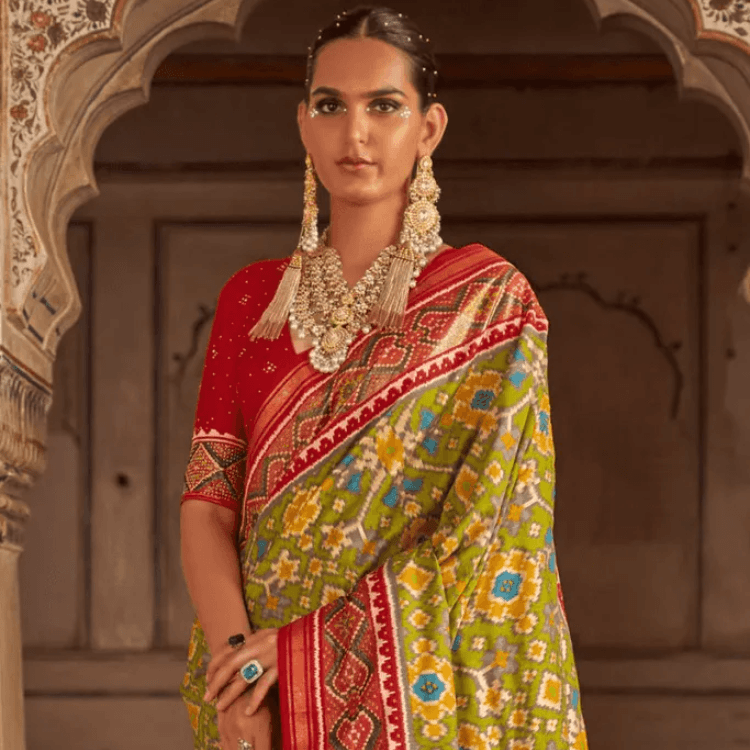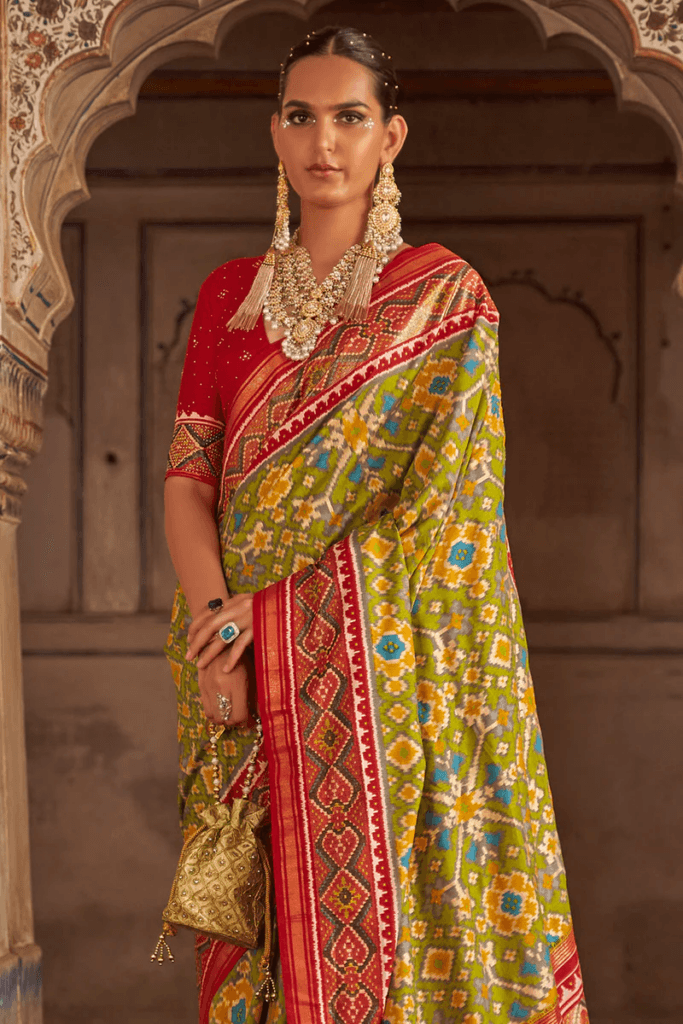
Your Cart
The Timeless Beauty of the Elegant Patola Sarees


The Patola sarees are rich handloom silk sarees from Gujarat, and the name translates to ‘queen of silks’. These sarees are known for their distinctive vibrant colours and are filled with motifs depicting animals and flowers. Did you know that the geometric motifs are so intricately and carefully woven into this textile that the saree can be worn both ways?
History of Patola Sarees ------------------------

Patola sarees are rich in texture and design, with a long history attached to them. The Patola saree designs have been in circulation since the 12th century CE. Interestingly, these designs are also observed on the walls of temples in Kerala and Tamil Nadu, which became prevalent in the 18th century CE.
These exquisite sarees are mainly woven at Patan in Gujarat, which is considered the hub of the artisans of this craft. It is believed that these travelling weavers once used it as one of their resting places. Today, Surat is another prominent centre of production. Other regions in the Indian subcontinent also have similar textile traditions. They resemble Patola sarees in terms of their appearance and the technique used in their making. Areas in Maharashtra, Karnataka and Telangana use the same ‘Ikat’ weaving technique; and those sarees are referred to as Ikat and Pochampally sarees.
Fabric in Patola Sarees -----------------------
The Patola sarees are made from silk fabric called Patola silk and are woven with intricate designs. Some higher-end varieties of these sarees also contain zari work. It allows them to be presented as remarkable works of visual expression. This complex craft's outcome shows the weavers' mastery and exceptional skills.
Time required and cost ----------------------
The Patola sarees are extremely beautiful and are worn mostly during weddings and other celebratory events. The flawless craftsmanship of the weavers entices buyers from all over the country, and at relatively high prices — the more complex the work, the more expensive the saree.
These sarees take a long time to make and can be worn on both sides. The making can take anywhere from almost six months to a year for the completion of one Patola saree. This makes weavers of these sarees famous for their splendid work.
A Status Symbol ---------------
The Patola saree has a high reverence in the local culture. These sarees have richly embroidered fabric and have a long history of tradition that comes with each saree. Since these require fine fabric and come with elaborate decoration, Patola sarees have always been a status symbol and represented the higher classes of Bhatia and Brahmin castes. In the earlier days, these rare and expensive sarees were only worn by royal and aristocratic families.
However, with increased production and the betterment of the financial condition of people in the subcontinent today, Patola sarees have become essentially important as bridal attire; and are also considered auspicious wedding outfits. The particular motif of the ‘chabardi bhat’ (flower basket) is seen as a symbol of fertility and is worn in several traditions for wedding rituals.
Different types of Patola Sarees --------------------------------
There are various types of Patola sarees, depending on the details and additional ornamentation of the sarees. But based on the place of origin and the respective process involved, there are two main varieties - Rajkot patola and Patan patola. Rajkot sarees are single ikat weaves and they are in vertical resist-dye. Patan Patola, on the other, is a double ikat weave and they are in horizontal resist-dye.
The beauty and uniqueness of Patola sarees have given them the quality of being present in the wardrobe of any saree or textile aficionado. The fabric and its intricate designs add to the beauty of Patola. These sarees are one of the most authentic Indian sarees. They are also one of the more expensive ones due to their elaborate crafting process and detailed designs. Patola sarees are, thus, a status symbol and no Gujarati bride wants to miss this in her collection on her wedding day. It is an experience a lot of women wish to fulfil.
The presence of this beautiful artwork for ages and the Indian culture it represents, with the designs even in temples since the medieval period, makes them unmissable. The double-ikat pattern and the magnificent zari work are the identities of Patola. Therefore, Indian households right from Bhatia to Brahmin merchants of Gujarat have at least one Patola saree in their collection. Now learning so much about the Patola saree, how can you not want to own one of these elegant sarees and be a proper patola?
### About Rooftop:
Rooftop is India’s leading online learning platform for live art workshops and professionally curated art courses. Such mindfully selected classes help bridge the gap between artists and art lovers to make art easily accessible and approachable to all those who seek it. Art experiences are carefully designed to fit your work life, so you can attend classes on the go, anytime, anywhere.
We offer a wide range of courses starting from Live art workshops. Rooftop is a place where passionate and skilled artists give voice and purpose to their art. From Maestro Courses and Art Therapies, Rooftop has it all. An app that not only offers creative services but connects art enthusiasts to form an exclusive art community like never seen before.